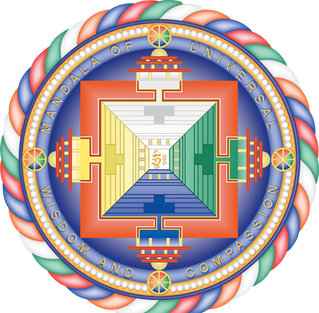
The Foundation for the Preservation of the Mahayana Tradition (FPMT) was founded in 1975 by Gelugpa Lamas Thubten Yeshe and Thubten Zopa Rinpoche, who began teaching Tibetan Buddhism to Western students in Nepal. The FPMT has grown to encompass over 138 dharma centers, projects, and services in 34 countries. Lama Yeshe led the organization until his death in 1984, followed by Lama Zopa until his death in 2023. The FPMT is now without a spiritual director; meetings on the organization's structure and future are planned.
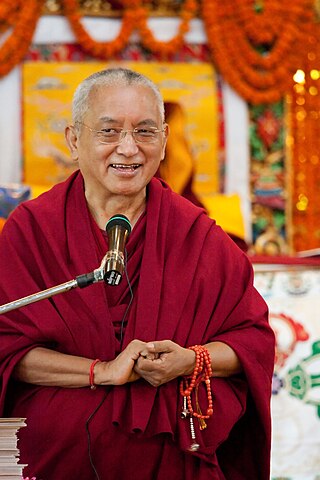
Thubten Zopa Rinpoche was a Tibetan Buddhist lama in the Gelug school. He is known for founding the Foundation for the Preservation of the Mahayana Tradition and Maitripa College in Portland, Oregon.

Sera Monastery is one of the "great three" Gelug university monasteries of Tibet, located 1.25 miles (2.01 km) north of Lhasa and about 5 km (3.1 mi) north of the Jokhang.

Pabongkhapa Déchen Nyingpo was a Gelug lama of the modern era of Tibetan Buddhism. He attained his Geshe degree at Sera Mey Monastic University, Lhasa, and became a teacher in Tibet. He teaches lay people. Pabongkha was offered the regency of the present Dalai Lama but declined the request because "he strongly disliked political affairs."

Kyabje Dudjom Rinpoche Jigdral Yeshe Dorje was known simply as Dudjom Rinpoche. He is considered by many Tibetan Buddhists to be from an important Tulku lineage of Terton Dudul Dorje (1615–1672), and was recognized as the incarnation of Terton Dudjom Lingpa (1835–1904), a renowned treasure revealer. He was a direct incarnation of both Padmasambhava and Dudjom Lingpa. He was a Nyingma householder, a yogi, and a Vajrayana and Dzogchen master. According to his secretary Khenpo Tsewang Dongyal and many others, he was revered as "His Holiness" (Kyabje) and as a "Master of Masters".

Gaden Tharpa Choling Monastery is a Gelugpa monastery situated at the top of Tirpa hills in Kalimpong, India. The monastery was founded by Domo Geshe Rinpoche Ngawang Kalsang in 1912.

Monlam, also known as The Great Prayer Festival, falls on the 4th to 11th day of the 1st Tibetan month in Tibetan Buddhism.
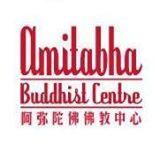
Amitabha Buddhist Centre is a Buddhist institution in Geylang, Singapore. It is affiliated with the Foundation for the Preservation of the Mahayana Tradition (FPMT), an international non-profit organisation, founded by Lama Thubten Yeshe.

Zong Rinpoche was a Gelug Lama and disciple of the third Trijang Rinpoche, junior tutor of the 14th Dalai Lama. He was famous as a sharp analyst and master of philosophical debate, as well as a Tantric practitioner. He was the Abbot of Ganden Shartse monastery.
Manjushri Institute was a large Buddhist college situated at Conishead Priory in Cumbria, England from 1976 until its dissolution in 1991. In 1991 its assets, including Conishead Priory, were transferred to a new centre on the same premises, Manjushri Mahayana Buddhist Centre, which was later renamed Manjushri Kadampa Meditation Centre.
Khensur Denma Locho Rinpoche also known as Lobsang Oser Choying Gyatso, was a Tibetan incarnate lama, or tulku, of the Loseling College of Drepung Monastery. An expert on Yamantaka and Vajrayogini, he is considered an incomparable luminary of Je Tsongkhapa's lineage, is renowned as a holder of the Tantric lineages, a master of the Tantric yogas, and the lineage holder of Ling Rinpoche.
Geshe Lama Konchog, born Lobsang Puntsog, was a Tibetan Buddhist lama of the Gelug school, who had thousands of followers around the world. Konchog was recognized by the Dalai Lama to be a Mahasiddha, or realized guru.
Geshe Tenzin Zopa is a Tibetan Buddhist monk of the Mahayana tradition. He is the resident teacher of the Losang Dragpa Centre of the Foundation for the Preservation of the Mahayana Tradition (FPMT). Zopa is featured in the 2008 documentary film Unmistaken Child, which follows his search for the reincarnation of his beloved master, Geshe Lama Konchog. Zopa has also written a book about this search, titled Precious Holy Child of Kopan.

Kyabje Yongzin Ling Rinpoche is a Tibetan tulku. The best-known incarnation is the sixth incarnation, Thupten Lungtok Namgyal Thinley, a Tibetan buddhist scholar and teacher.
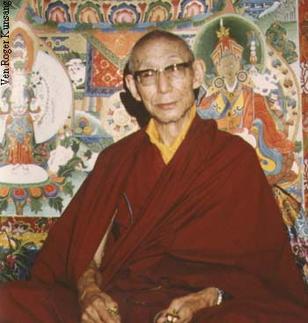
The Third Trijang Rinpoche, Lobsang Yeshe Tenzin Gyatso (1901–1981) was a Gelugpa Lama and a direct disciple of Pabongkhapa Déchen Nyingpo. He succeeded Ling Rinpoche as the junior tutor of the 14th Dalai Lama when the Dalai Lama was nineteen years old. He was also a lama of many Gelug lamas who taught in the West including Zong Rinpoche, Geshe Rabten, Lama Yeshe, Kelsang Gyatso, and Lama Zopa Rinpoche. Trijang Rinpoche's oral teachings were recorded by Zimey Rinpoche in a book called the Yellow Book.

(Kyabje) Choden Rinpoche was a contemporary yogi-scholar of the Gelugpa school of Tibetan Buddhism and a reincarnation ('sprul-sku') of the Choden lineage, the historical abbots of Rabten Monastery (Tibetan: རབ་བརྟེན་དགོན་པ, Wylie: in Rong-bo district, Kham.

The Tibet Center, also known as Kunkhyab Thardo Ling, is a dharma center for the study of Tibetan Buddhism. Founded by Venerable Khyongla Rato Rinpoche in 1975, it is one of the oldest Tibetan Buddhist centers in New York City. The current director is Khen Rinpoche Nicholas Vreeland, the abbot of Rato Dratsang monastery. Philip Glass assisted with the founding of The Tibet Center. Since 1991 TTC has invited and hosted the 14th Dalai Lama for teaching events in New York in partnership with the Gere Foundation.
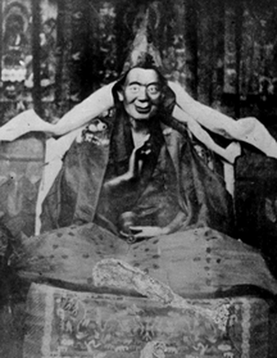
Domo Geshe Rinpoche is said to have been Shariputra, the Mahadsiddha Gayadhara, Dharmashri, Munijnana, Tönmi Sambhota, King Trisong Detsen, Dromtönpa, Milarepa, Khedrup Rinpoche, and Dragpa Gyaltsen in previous lives.
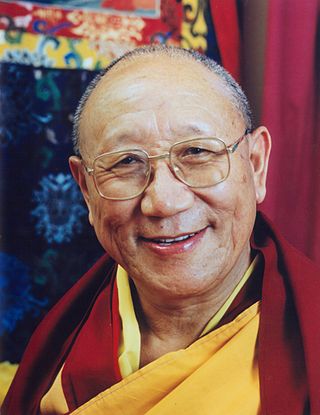
Kyabje Khensur Kangurwa Lobsang Thubten Rinpoche, was a Buddhist monk, Abbot of Sera Jey Monastery, and the founder of Tibetan Buddhist Institute (Adelaide). Khensur means "former abbot" and Rinpoche means "precious teacher."

Singha Thekchen Namdrol Rinpoche, is a Buddhist teacher and the Spiritual Director of the Thekchen Choling centres in Singapore, Malaysia and in the United States (Syracuse).


























